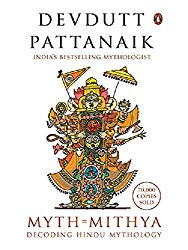“Myth = Mithya” is “a handbook of Hindu mythology” written by the prolific Indian author Devdutt Pattanaik that seeks to gently guide the reader through the vast set of somewhat confusing myths that are generally considered to form this mythology. Through this process, the author expounds upon the underlying philosophical framework that binds this mythology.
The author distinguishes between “God” and “god” - the former being manifestations of the infinite divine and the latter being finite forms of the divine - Brahma, Vishnu, and Shiva are Gods, while there are 330 million gods and goddesses like Indra, Agni, Vayu, etc. The three chapters in the book revolve around the three Gods, respectively symbolizing the creation, protection, and destruction of the universe. Even though the author insists that you can read the chapters in any order, it is better to tackle them sequentially, at least on a first reading.
Each chapter explores various aspects of the respective God, introduces sundry associated gods and goddesses and is peppered with tables, figures, diagrams, and tales from various sources to enliven the text. I found the tales to be nice and revelatory, the tables mostly tolerable, and the diagrams to be mostly irritating.
Many of the tables seem quite forced and look as if written by a middle-school student answering a question of the form “What are the main differences between god A and god B? List at least ten.” Most of the diagrams confound rather than inform - there are some truly bizarre diagrams here that left me scratching my head (e.g. the one contrasting the rattle-drum of Shiva and the discus of Vishnu). Together with some of the grammatical errors and errors of composition visible in the text, this makes me wonder if there was even a copy editor assigned to this book, let alone a capable editor.
The author avoids using italics, unlike the usual practice, to denote non-English words in the text. This gets quite confusing when terms like “sat” (the absolute truth) are used, which are also common English words. It would have also helped a lot if such terms were also written in the Devanagari script (apart from Latin), at least for the first occurrence or even in the glossary provided in the end, to help the (I guess the majority of) readers who could benefit from such an aide.
The book is quite small and assumes a general familiarity with the major Hindu epics (or at least their story-arcs and dramatis personae). It generally plays safe and does not tread into any controversial topics (unlike The Hindus). The general impression one gets from reading this book is that of a single philosophical framework underlying Hinduism with only minor disagreements here and there among its adherents, which is in stark contrast to what seems to be the reality across millennia.
If you are an Indian, especially one whose only exposure to Hindu mythology has been through TV-series, films, or Amar Chitra Katha comics, you ought to read this book to get a bigger picture and for exposure to the aspects of this mythology that such media coyly omit.
